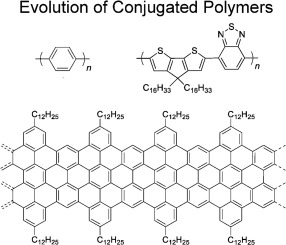Progress in Polymer Science ( IF 26.0 ) Pub Date : 2019-11-13 , DOI: 10.1016/j.progpolymsci.2019.101179 Zijie Qiu , Brenton A.G. Hammer , Klaus Müllen

|
Conjugated polymers (CPs) are unique in their synthetic challenges to tailor their chemical, electronic, and processing properties while identifying significant structure-to-property correlations. Over the past half century chemists have worked towards synthesizing more complex and solution processable conjugated polymers while approaching structural perfection. These efforts aim to maximize their beneficial properties such as high charge mobilities, impressive absorption and emission signals, as well as the ability to stabilize charges, among others. Yet, chemists have only scratched the surface of these characteristics, and new synthetic approaches continue to elevate the field of conjugated polymers. The processability of CPs is no longer solely dependent on adding solubilizing chains to the macromolecules, but can be achieved through polymerizing soluble derivatives that can undergo post-polymerization modification resulting in the desired CPs. New step-growth and chain-growth polymerization techniques have been discovered to provide control over polymerization of CPs to manipulate their molecular weight and molecular weight distribution, in addition to producing new “donor-acceptor” copolymers that have enhanced electronic and photophysical properties. Additionally, graphene nanoribbons can be synthesized with atomic precision along their edges to control their charge transport properties, and even their ability to create spins along their periphery for potential use in spintronics. New vapor-phase polymerization techniques have made it possible to create thin films of poorly soluble polymers without the need for toxic solvents, and recent breakthroughs in aryl-aryl couplings have eliminated the need for toxic and expensive reagents. Furthermore, strides have been made to bridge electrodes in organic devices with either small molecules or CPs in attempts of achieving single molecule devices, while chemists have also pursued expanding CPs into the second dimension in an effort to improve their charge carrier mobilities. In honor of Staudinger’s 100th anniversary of identifying the field of polymer chemistry this article will outline how the synthetic evolution of conjugated polymers has resulted in the aforementioned properties, among others, and how these materials have opened the door for many state-of-the-art applications.
中文翻译:

共轭聚合物–问题和承诺
共轭聚合物(CP)在应对合成挑战方面具有独特性,可在确定重要的结构与性能相关性的同时定制其化学,电子和加工性能。在过去的半个世纪中,化学家一直在努力合成更复杂和可溶液处理的共轭聚合物,同时达到结构上的完美。这些努力旨在最大化其有益性能,例如高电荷迁移率,令人印象深刻的吸收和发射信号以及稳定电荷的能力等。然而,化学家们只是摸索了这些特性的表面,而新的合成方法仍在继续提升共轭聚合物的领域。CP的可加工性不再仅仅依赖于向大分子添加增溶链,但是可以通过聚合可溶的衍生物来实现,这些衍生物可以进行聚合后修饰,从而得到所需的CP。除了生产具有增强的电子和光物理性质的新型“供体-受体”共聚物外,还发现了新的逐步增长和链增长聚合技术可控制CP的聚合,以控制其分子量和分子量分布。此外,石墨烯纳米带可以沿其边缘以原子精度合成,以控制其电荷传输性质,甚至可以沿其外围产生自旋的能力,以用于自旋电子学。新的气相聚合技术使制造难溶性聚合物薄膜成为可能,而无需使用有毒溶剂,最近在芳基-芳基偶联方面的突破消除了对有毒和昂贵试剂的需求。此外,为实现单分子器件,已经迈出了跨越小分子或CPs桥接有机器件中的电极的步伐,同时化学家还试图将CPs扩展到第二维以努力改善其电荷载流子迁移率。为了纪念施陶丁格(Staudinger)诞辰100周年个识别聚合物化学领域本文将概述共轭聚合物的合成如何进化已经导致上述性质,等等周年,以及这些材料如何都开了许多国家的最先进的应用程序的门。











































 京公网安备 11010802027423号
京公网安备 11010802027423号